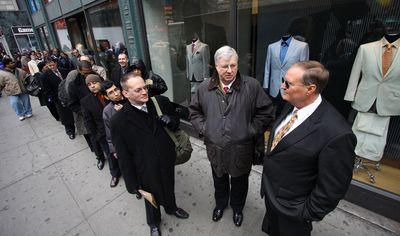Fed says economy will continue to worsen in 2009
Unemployment could climb to 8.8 percent

WASHINGTON – The Federal Reserve warned Wednesday that the nation’s crippled economy is even worse than thought and predicted it would deteriorate throughout 2009, with no sign that the housing market will stabilize.
The Fed’s bleak estimates indicated that unemployment could climb as high as 8.8 percent this year and that the economy would contract for a full calendar year for the first time since 1991.
The central bank’s latest projections came hours after a separate report showed that new home construction and applications for future projects both fell to record lows last month.
Still, some economists saw a silver lining in the otherwise dismal housing report: Scaled-back building should reduce the number of unsold homes and contribute to an eventual housing recovery.
The Fed’s latest forecast says the unemployment rate will climb to between 8.5 and 8.8 percent this year. The old prediction, issued in mid-November, estimated that the jobless rate would rise to between 7.1 and 7.6 percent.
Many private economists believe the current 7.6 percent jobless rate – the highest in more than 16 years – will hit at least 9 percent by early next year even with the $787 billion stimulus package signed into law Tuesday by Obama.
The Fed also believes the economy will contract this year between 0.5 and 1.3 percent. The old forecast said the economy could shrink by 0.2 percent or expand by 1.1 percent.
The last time the economy registered a contraction for a full year was in 1991, by 0.2 percent. If the Fed’s new predictions prove correct, it would mark the weakest showing since a 1.9 percent drop in 1982, when the country had suffered through a severe recession.
The grim outlook represents the growing toll of the worst housing, credit and financial crises since the 1930s. All of those negative forces have plunged the nation into a recession, now in its second year.
“Given the strength of the forces currently weighing on the economy,” Fed officials “generally expected that the recovery would be unusually gradual and prolonged,” according to documents on the Fed’s updated economic outlook.
In another sign of the troubled economy, production at the nation’s factories, mines and utilities fell 1.8 percent last month, more than economists expected. That figure, the third monthly drop in a row, was dragged down by a 23 percent drop in production at auto plants and their suppliers.
Meanwhile, construction of new homes and apartments plummeted 16.8 percent in January from the previous month, the Commerce Department said, falling to a seasonally adjusted annual rate of 466,000 units. Analysts expected a pace of 530,000 housing units.
Building permits, a measure of future activity, also sank to a record low pace of 521,000 units in January, a 4.8 percent drop from the prior month.
“Conditions in the market for new homes have not been this bad since the 1930s, and they continue to worsen,” said Patrick Newport, an economist at IHS Global Insight in Lexington, Mass. He predicted that housing starts would remain depressed for months to come.
But other economists saw some glimmers of hope in the report. The sharp cuts in new home building should help reduce inventories of unsold homes, which reached record levels last year, and stabilize home prices, which have been battered by a flood of foreclosed homes on the market.
Abiel Reinhart, an economist at JPMorgan Chase & Co., said that reduced homebuilding lowers economic growth in the short run, “but it does help get inventories down to more reasonable levels.”
Builders have cut the number of new homes on the market for almost two years, Newport said, but sales have fallen even more quickly. As a result, the Commerce Department said last month that it would take 12.9 months to sell all the new homes on the market, the longest on record.
That could drop closer to five to six months by the end of this year, Reinhart said, levels that are consistent with a more stable market.